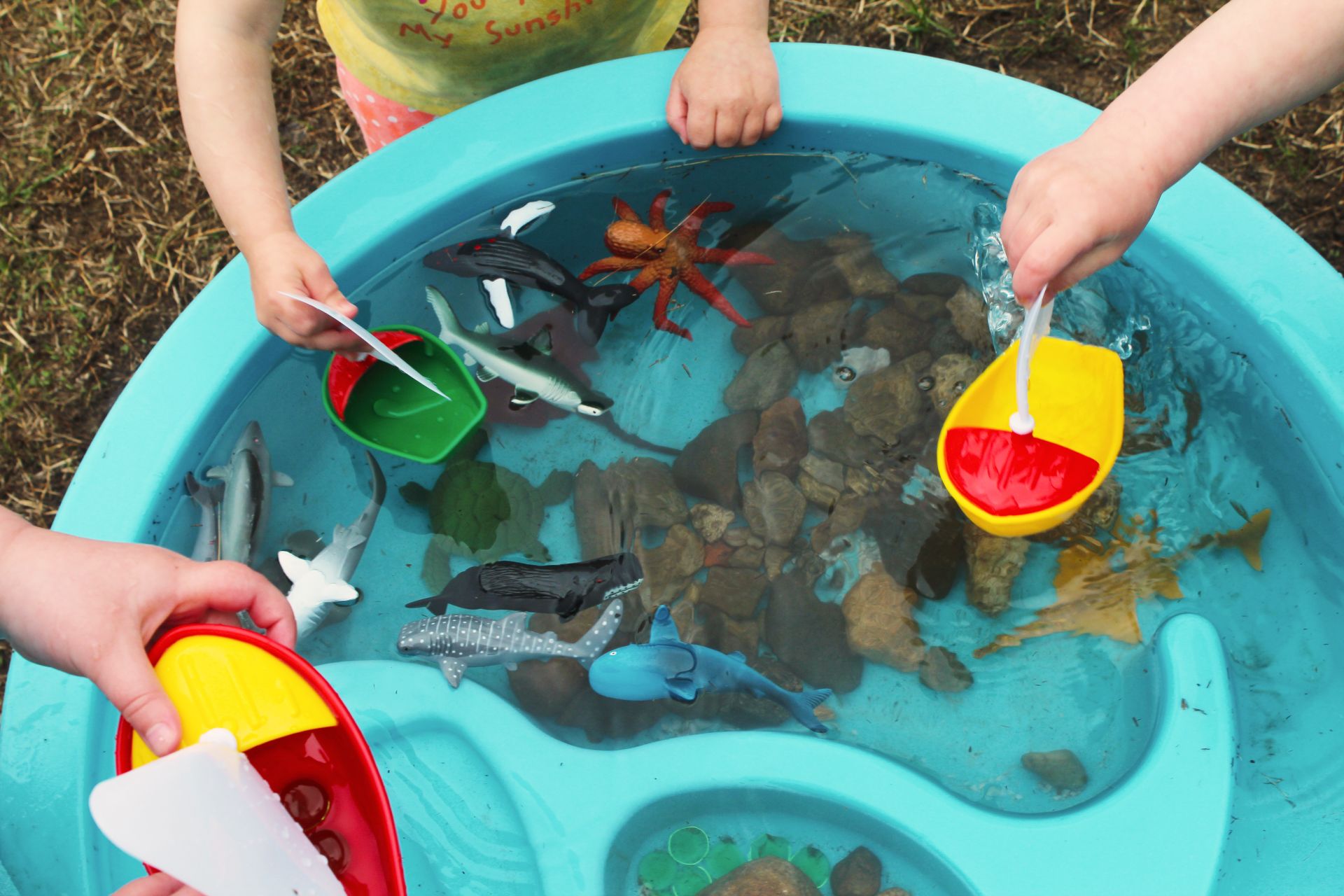Sun Safety & Water Play
A Summer Guide to Keeping Cool & Staying Safe for
Early Childhood Educators
Summer in early childhood programs brings a joyful mix of sunshine, water play, and outdoor exploration. For many children, it’s a time of sensory-rich learning, social connection, and freedom to move. But with the joys of summer come real safety responsibilities, especially for educators who care for our youngest learners.
Let’s walk through some essential summer safety tips—from sun protection and hydration to inclusive water play practices—designed to keep all children safe, regulated, and engaged.
Let’s walk through some essential summer safety tips—from sun protection and hydration to inclusive water play practices—designed to keep all children safe, regulated, and engaged.

Sun Safety for Young Children
Protecting children from sunburn and overheating is a top priority during summer months. Young children’s skin is especially sensitive.
Best Practices for Sun Protection:
- Apply sunscreen with an SPF of 30 or higher at least 15–30 minutes before outdoor play, even on cloudy days.
- Look for sunscreen labeled “water resistant” and “broad-spectrum” which means it provides protection from both types of harmful UV rays (UVA and UVB).
- Reapply sunscreen every 2 hours. For water-resistant sunscreen, reapply every 40-80 minutes after water play or sweating.
- For infants under 6 months, sunscreen is not recommended. This is because of their inability to metabolize sunscreen ingredients. Instead, keep children younger than 6 months out of direct sunlight. Rely on shaded areas in outdoor spaces (for example: trees, buildings, or shade structures like awnings, canopies, sun umbrellas, and sunshades). Additional tools to limit sun exposure include wide-brimmed hats or lightweight long sleeves.
- Consider using mineral-based sunscreens with zinc oxide or titanium dioxide for sensitive skin. These are also known as physical sunscreens, and they block the sun’s rays by reflecting them off of the skin. Mineral sunscreens are less likely to irritate (so they’re preferred for sensitive skin) and provide immediate protection, but they don’t need to be aggressively rubbed in. Many come in fun colors that children enjoy.
For additional guidance on selecting sunscreen, check out this article from the American Academy of Dermatology.
Inclusion Tip for Neurodivergent Children:
Neurodivergent children or children with sensory sensitivity may require extra assistance.
Make sunscreen application part of a predictable routine with visual cues and gentle guidance. If children are sensitive to touch or textures, allow them to apply sunscreen themselves (with adult support), or explore alternate forms like sunscreen sticks. Sensory-sensitive children may find roll-
Make sunscreen application part of a predictable routine with visual cues and gentle guidance. If children are sensitive to touch or textures, allow them to apply sunscreen themselves (with adult support), or explore alternate forms like sunscreen sticks. Sensory-sensitive children may find roll-

on or spray sunscreen preferable to the conventional pump or squeeze bottle, since it doesn’t require a hand to spread the sunscreen directly on their skin. Sun-protective clothing or a comfortable hat are also good options for kids who have difficulty tolerating the application or the feel of sunscreen. Additional strategies to support children include: turn-taking (my turn, then your turn), using visual supports or visual aids, or a social story about sun safety.
Keeping Little Bodies Hydrated in the Heat
Young children are more vulnerable to heat-related illness because they sweat less and their bodies heat up faster. Dehydration can sneak up quickly in busy classrooms, especially for kids who are nonverbal or have difficulty communicating basic needs.
Strategies for Preventing Overheating:
- Offer cool drinking water throughout the day. Children often forget to drink until they’re very thirsty—so build water breaks into your routine.
- Use visual supports like picture cards or “water station” signs for non-speaking children to request a drink.
- Serve hydrating snacks like watermelon, cucumber slices, and peaches prepared in an age-appropriate manner.
- Make sure children have access to cooling strategies such as shaded rest areas, cool cloths, or water mist fans.
- When the heat index is high or a heat advisory is issued for your area, you may need to limit outdoor play and bring activities inside. Check with your local public health agency or licensor for guidelines specific to your region.
Safe, Inclusive Water Play in Early Childhood Classrooms
Water play is often a source of joy and delight for young children. Water play is one of the best ways to support sensory exploration, fine motor skills, and peer interaction. But to be safe and accessible, it requires thoughtful setup and active supervision.
Water Play Essentials:
- Always maintain close, active supervision during water activities. This is important even with shallow water. Drowning can happen in less than 2 inches of water and within seconds.
- Avoid hard or slick surfaces under water tables or sprinklers. Use non-slip mats or take water play to grassy areas.
- Make sure children have a change of clothes available. Change clothing after water play to prevent chills and regulate body temperature. Even in hot weather, wet clothes or wet hair can cause a rapid drop in body heat.
- Use only clean, fresh water for daily activities. Empty and sanitize water tables or bins after each use to prevent the spread of germs.
Inclusion Tip: Some children may be sensory-seeking and love getting wet, while others may be more sensory-avoiding during water play activities. Provide choice and flexibility. Offer dry options like cups, funnels, spray bottles, and pipettes so children can engage in water play without directly getting wet. Set up parallel play stations so children can observe without pressure. For children with motor differences, use adaptive tools like wide-handled scoops.

Making Summer Play Work for Everyone
Summer is a season filled with sunshine, sensory-rich experiences, and endless opportunities for exploration. Creating an inclusive, summer-safe environment means more than just slathering on sunscreen. It means building daily routines that protect children from heat and sun exposure, while making sure all children—regardless of ability, sensory preferences, or developmental needs—can fully participate in the fun.
Want to Keep Building Your Toolkit?
If you’re looking for even more safety tips and strategies to enhance your teacher toolkit this summer, enroll in our Toddler Summer Bundle. Save 30% on two on-demand courses with this limited time offer: Bye Bye Biting – Strategies for Prevention and Response and Shadowing to Prevent Challenging Behavior. Let this summer season be full of cool splashes, warm connections, and learning new strategies to support children!
- The IMPACT Team
- The IMPACT Team
If you're interested in learning more about supporting children with ADHD, Autism, or sensory regulation, check out these courses:
IMPACT™ content is developed by a multidisciplinary team and makes every effort to ensure that information provided reflect evidence-based, early childhood best practices. Providers should always follow local jurisdictions and other governing bodies rules and regulations when implementing any strategy or suggestion. Any actions, or lack of actions, are not the responsibility or liability of Northwest Center Kids – IMPACT™.
All content, including the presentation thereof on this web site, is the property of Northwest Center IMPACT™, and protected by U.S. and international copyright laws. You may not copy, reproduce, distribute, transmit, modify, create derivative works, or in any other way exploit any part of copyrighted material without the prior written permission from Northwest Center.
All content, including the presentation thereof on this web site, is the property of Northwest Center IMPACT™, and protected by U.S. and international copyright laws. You may not copy, reproduce, distribute, transmit, modify, create derivative works, or in any other way exploit any part of copyrighted material without the prior written permission from Northwest Center.
Connect
-
Seattle, WA
-
impact@nwcenter.org
-
NWC Home
Policy pages
Subscribe & stay up to date
Thank you!
Copyright © 2025
IMPACT™ content is developed by a multidisciplinary team and makes every effort to ensure that information provided reflect evidence-based, early childhood best practices. Providers should always follow local jurisdictions and other governing bodies rules and regulations when implementing any strategy or suggestion. Any actions, or lack of actions, are not the responsibility or liability of Northwest Center Kids – IMPACT™. All content, including the presentation thereof on this web site, is the property of Northwest Center IMPACT™, and protected by U.S. and international copyright laws. You may not copy, reproduce, distribute, transmit, modify, create derivative works, or in any other way exploit any part of copyrighted material without the prior written permission from Northwest Center.
